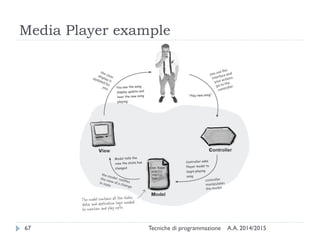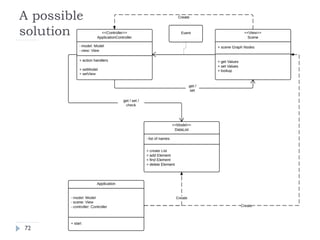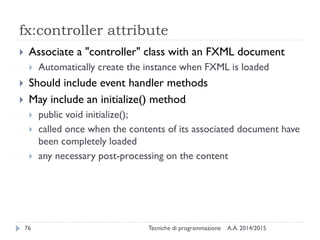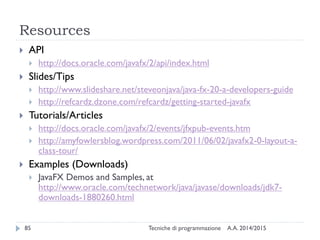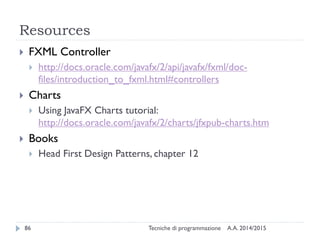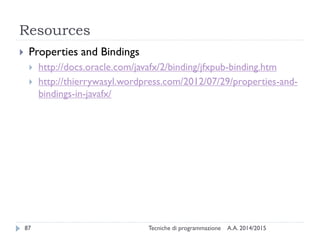Programming with JavaFX
- 1. Programming with JavaFX Tecniche di Programmazione – A.A. 2014/2015
- 2. Summary A.A. 2014/2015Tecniche di programmazione2 1. About and History 2. Basic concepts 3. Minimal JavaFX Application 4. Application structure 5. The Scene Graph 6. Events 7. Model-View-Controller 8. The Controller in FXML 9. Properties and bindings 10. Resources
- 3. About and History Introduction to JavaFX
- 4. GUI in Java A.A. 2014/2015Tecniche di programmazione4 Graphic framework available in Java Swing Extremely powerful, many extensions available Complex to master, requires low-level handling Hard to create visually pleasing applications Alternatives available Most notable: SWT (Eclipse) Still cumbersome to master On a different Universe, web-based user interfaces became nicer and faster to create
- 5. JavaFX 1.0 – forget it A.A. 2014/2015Tecniche di programmazione5 JavaFX 1 and JavaFX 2 are completely different Version 1 relied on a “scripting language” to describe scenes, with ‘hooks’ to activate Java code JavaFX 1.x is now deprecated
- 6. JavaFX 2.x A.A. 2014/2015Tecniche di programmazione6 Redesigned from scratch The JavaFX 2.x framework is entirely written in Java For visual layout, an XML file may also be used (called FXML) Graphic appearance borrows from web-standard CSS style sheets UI programming is based on easy to handle events and bindings Oracle plans to deprecate Swing in favor of JavaFX 2 Now called JavaFX 8 (after Java 8 – JDK 1.8)
- 7. Getting and running JavaFX A.A. 2014/2015Tecniche di programmazione7 JavaFX is already included in Oracle JDK 7 and JDK8 Not in JDK 6.x Not in OpenJDK (beware, Linux users!) JDK 8 includes significant JavaFX improvements. Recommended: JavaFX Scene Builder Eclipse: e(fx)clipse plugin, available in the Eclipse Marketplace Download links are in the course webpage
- 8. Basic concepts Introduction to JavaFX
- 9. Key concepts in JavaFX A.A. 2014/2015Tecniche di programmazione9 Stage: where the application will be displayed (e.g., a Windows’ window) Scene: one container of Nodes that compose one “page” of your application Node: an element in the Scene, with a visual appearance and an interactive behavior. Nodes may be hierarchically nested My best friend is the JavaFX JavaDoc API http://docs.oracle.com/javase/8/javafx/api/
- 10. Some ‘Leaf’ Nodes (Controls) A.A. 2014/2015Tecniche di programmazione10
- 11. Some ‘Parent’ Nodes (Container ‘Panes’) A.A. 2014/2015Tecniche di programmazione11 BorderPane (5-areas) Hbox,Vbox (linear sequence) StackPane (overlay all children) GridPane (row x columns) FlowPane (flowing boxes, wrap around) TilePane (flowpane with equally sized boxes) AnchorPane (magnetically attach nodes at corners or sides)
- 12. Some Nodes (Charts) A.A. 2014/2015Tecniche di programmazione12
- 13. Nodes family A.A. 2014/2015Tecniche di programmazione13 javafx.scene.Node Parent Control ChoiceBox ComboBoxBase ColorPicker ComboBox Labeled ButtonBase Button CheckBox MenuButton ToggleButton Cell Label TitledPane ListView MenuBar Separator Slider TabPane TextInputControl TextArea TextField ToolBar TreeView Group Region Axis Chart Pane AnchorPane BorderPane FlowPane GridPane HBox StackPane TilePane VBox WebView Shape Arc Circle Line Polygon Polyline Rectangle Text Canvas Imageview Focus on Panes and Controls
- 14. And more coming… A.A. 2014/2015Tecniche di programmazione14 http://jfxtras.org/
- 15. And more coming… A.A. 2014/2015Tecniche di programmazione15 http://fxexperience.com/controlsfx/
- 16. Empty JavaFX window A.A. 2014/2015Tecniche di programmazione16 public class Main extends Application { @Override public void start(Stage stage) { Group root = new Group(); // the root is Group or Pane Scene scene = new Scene(root, 500, 500, Color.BLACK); stage.setTitle("JavaFX Demo"); stage.setScene(scene); stage.show(); } public static void main(String[] args) { launch(args); } }
- 17. Adding some shape A.A. 2014/2015Tecniche di programmazione17 public class Main extends Application { @Override public void start(Stage stage) { Group root = new Group(); Scene scene = new Scene(root, 500, 500, Color.BLACK); stage.setTitle("JavaFX Demo"); Rectangle rect = new Rectangle(25,25,250,250); r.setFill(Color.BLUE); root.getChildren().add(rect); stage.setScene(scene); stage.show(); } }
- 18. How to add scene content A.A. 2014/2015Tecniche di programmazione18 In Java code By creating and adding new Node subclasses Standard way, in Java (boring and error-prone) By using node Builder classes Programming pattern, later on… In FXML By writing XML directly By using the Scene Editor And loading the FXML into the application
- 19. JavaFX Scene Builder 2.0 A.A. 2014/2015Tecniche di programmazione19
- 20. FXML fragment A.A. 2014/2015Tecniche di programmazione20 . . . <HBox id="HBox" alignment="CENTER" spacing="15.0" AnchorPane.rightAnchor="23.0" AnchorPane.topAnchor="22.0"> <children> <Button id="button1" fx:id="newIssue" onAction="#newIssueFired" text="New" /> <Button id="button2" fx:id="saveIssue" onAction="#saveIssueFired" text="Save" /> <Button id="button3" fx:id="deleteIssue" onAction="#deleteIssueFired" text="Delete" /> </children> </HBox> <ImageView id="IssueTrackingLite" layoutX="14.0" layoutY="20.0"> <image> <Image url="@IssueTrackingLite.png" preserveRatio="true" smooth="true" /> </image> </ImageView> . . .
- 21. Building a scene from FXML A.A. 2014/2015Tecniche di programmazione21 public void start(Stage stage) throws Exception { Parent root = FXMLLoader.load( getClass().getResource("circle.fxml")); stage.setTitle("Circle Demo"); stage.setScene(new Scene(root, 500, 150)); stage.show(); }
- 22. Application structure Introduction to JavaFX
- 23. Separation of concerns A.A. 2014/2015Tecniche di programmazione23
- 24. Typical Class Diagram A.A. 2014/2015Tecniche di programmazione25
- 25. General rules A.A. 2014/2015Tecniche di programmazione26 A JavaFX application extends javafx.application.Application The main() method should call Application.launch() The start() method is the main entry point for all JavaFX applications Called with a Stage connected to the Operating System’s window The content of the scene is represented as a hierarchical scene graph of nodes Stage is the top-level JavaFX container Scene is the container for all content
- 26. Minimal example A.A. 2014/2015Tecniche di programmazione27 public class HelloWorld extends Application { public static void main(String[] args) { launch(args); } @Override public void start(Stage primaryStage) { primaryStage.setTitle("Hello World!"); StackPane root = new StackPane(); Button btn = new Button(); btn.setText("Say 'Hello World'"); root.getChildren().add(btn); primaryStage.setScene(new Scene(root, 300, 250)); primaryStage.show(); } }
- 27. Stage vs. Scene javafx.stage.Stage javafx.scene.Scene A.A. 2014/2015Tecniche di programmazione28 The JavaFX Stage class is the top level JavaFX container. The primary Stage is constructed by the platform. Additional Stage objects may be constructed by the application. A stage can optionally have an owner Window. The container for all content in a scene graph The application must specify the root Node for the scene graph Root may be Group (clips), Region, Control (resizes) If no initial size is specified, it will automatically compute it
- 28. Nodes A.A. 2014/2015Tecniche di programmazione29 The Scene is populated with a tree of Nodes Layout components UI Controls Charts Shapes Nodes have Properties Visual (size, position, z-order, color, ...) Contents (text, value, data sets, ...) Programming (event handlers, controller) Nodes generate Events UI events Nodes can be styled with CSS
- 29. Events A.A. 2014/2015Tecniche di programmazione30 FX Event (javafx.event.Event): Event Source => a Node Event Target Event Type Usually generated after some user action ActionEvent,TreeModificationEvent, InputEvent, ListView.E ditEvent, MediaErrorEvent,TableColumn.CellEditEvent,Tre eItem.TreeModificationEvent,TreeView.EditEvent,WebEve nt,WindowEvent,WorkerStateEvent You can define event handlers in your application
- 30. Properties A.A. 2014/2015Tecniche di programmazione31 Extension of the Java Beans convention May be used also outside JavaFX Encapsulate properties of an object Different types (string, number, object, collection, ...) Set/Get Observe changes Supports lazy evaluation Each Node has a large set of Properties
- 31. Bindings A.A. 2014/2015Tecniche di programmazione32 Automatically connect («bind») one Property to another Property Whenever the source property changes, the bound one is automatically updated Multiple bindings are supported Lazy evaluation is supported Bindings may also involve computations (arithmetic operators, if-then-else, string concatenation, ...) that are automatically evaluated May be used to automate UI May be used to connect the Model with theView
- 32. The Scene graph Introduction to JavaFX
- 33. Nodes A.A. 2014/2015Tecniche di programmazione34 Root node: top level container Intermediate nodes: Containers Layout managers UI Composite controls Leaf (terminal) nodes: Shapes UI Controls Organized as a Hierarchical tree
- 34. Nodes family A.A. 2014/2015Tecniche di programmazione35 javafx.scene.Node Parent Control ChoiceBox ComboBoxBase ColorPicker ComboBox Labeled ButtonBase Button CheckBox MenuButton ToggleButton Cell Label TitledPane ListView MenuBar Slider TabPane TextInputControl TextArea TextField ToolBar TreeView Group Region Axis Chart Pane AnchorPane BorderPane FlowPane GridPane HBox StackPane TilePane VBox WebView Shape Arc Circle Line Polygon Rectangle Text Canvas Imageview JavaDoc is your friend Focus on Panes and Controls
- 35. Exploring Controls and Examples A.A. 2014/2015Tecniche di programmazione36 JavaFX Ensemble demo application Download from Oracle site: JavaFX Demos and Samples Downloads Run Ensemble.jnlp
- 36. UI Form Controls A.A. 2014/2015Tecniche di programmazione37 Controls may be combined to construct «Forms» Control Nodes have a value property May be linked to application code Control Nodes generate UI Events Button:ActionEvent Text: ActionEvent, KeyTyped, KeyPressed, MouseClicked, ...
- 37. A.A. 2014/2015Tecniche di programmazione38
- 38. Layout Class Hierarchy A.A. 2014/2015Tecniche di programmazione39 Group: Doesn’t perform any positioning of children. To statically assemble a collection of nodes in fixed positions To apply an effect or transform to that collection. Region: base class for all general purpose layout panes resizable and stylable via CSS Supports dynamic layout by sizing and positioning children Control: the base class for all skinnable controls resizable and subclasses are all stylable via CSS Controls delegate layout to their skins (which are Regions) Each layout Control subclass provides API for adding content in the appropriate place within its skin you do not add children to a control directly.
- 39. A.A. 2014/2015Tecniche di programmazione40
- 40. A.A. 2014/2015Tecniche di programmazione41
- 41. A.A. 2014/2015Tecniche di programmazione42
- 42. A.A. 2014/2015Tecniche di programmazione43
- 43. A.A. 2014/2015Tecniche di programmazione44
- 44. A.A. 2014/2015Tecniche di programmazione45
- 45. A.A. 2014/2015Tecniche di programmazione46
- 46. A.A. 2014/2015Tecniche di programmazione47
- 47. Creating the Scene Graph A.A. 2014/2015Tecniche di programmazione48 The Java way Create Control Nodes Set properties to new nodes Add new nodes to parent node With Constructors and/or with Builders The FXML way Create a FXML file Define Nodes and Properties in FXML Load the FXML (Optionally, add new nodes/properties the Java way)
- 48. Example: one text input field A.A. 2014/2015Tecniche di programmazione49 TextField text = new TextField("Text"); text.setMaxSize(140, 20); root.getChildren().add(text); TextField text = TextFieldBuilder().create() .maxHeight(20).maxWidth(140) .text("Text") .build() ; root.getChildren().add(text); Constructors Builders
- 49. A.A. 2014/2015Tecniche di programmazione50 public class HelloDevoxx extends Application { public static void main(String[] args) { launch(args); } @Override public void start(Stage primaryStage) { primaryStage.setTitle("Hello Devoxx"); Group root = new Group(); Scene scene = new Scene(root, 400, 250, Color.ALICEBLUE); Text text = new Text(); text.setX(105); text.setY(120); text.setFont(new Font(30)); text.setText("Hello Devoxx"); root.getChildren().add(text); primaryStage.setScene(scene); primaryStage.show(); } }
- 50. A.A. 2014/2015Tecniche di programmazione51 public void start(Stage primaryStage) { primaryStage.setTitle("Hello Devoxx"); primaryStage.setScene(SceneBuilder.create() .width(400).height(250).fill(Color.ALICEBLUE) .root(GroupBuilder.create().children( TextBuilder.create() .x(105).y(120) .text("Hello Devoxx") .font(new Font(30)).build() ).build() ).build()); primaryStage.show(); }
- 51. The FXML way... A.A. 2014/2015Tecniche di programmazione52 XML-based format Nested tree of XML Elements, corresponding to Nodes XML Attributes corresponding to (initial) properties of nodes JavaFX Scene Builder is a GUI for creating FXML files The FXMLLoader class reads a FXML file and creates all the Nodes
- 52. Example A.A. 2014/2015Tecniche di programmazione53
- 53. JavaFX Scene Builder A.A. 2014/2015Tecniche di programmazione54
- 54. FXMLLoader A.A. 2014/2015Tecniche di programmazione55 @Override public void start(Stage stage) throws Exception { Parent root = FXMLLoader.load( getClass().getResource("fxml_example.fxml")); stage.setTitle("FXML Welcome"); stage.setScene(new Scene(root, 300, 275)); stage.show(); }
- 55. Linking FXML and Java A.A. 2014/2015Tecniche di programmazione56 FXML element may have an associated attribute fx:id Nodes may be later retrieved by public Node lookup(java.lang.String selector) Finds a node with a specified ID in the current sub-tree Example: scene.lookup("#myId"); Node references can also be «injected» using the @FXML annotation (see later)
- 57. Interacting with Nodes A.A. 2014/2015Tecniche di programmazione58 In JavaFX applications, events are notifications that something has happened. An event represents an occurrence of something of interest to the application As a user clicks a button, presses a key, moves a mouse, or performs other actions, events are dispatched. Registered event filters and event handlers within the application receive the event and provide a response.
- 58. What is an event? A.A. 2014/2015Tecniche di programmazione59
- 59. Event propagation A.A. 2014/2015Tecniche di programmazione60 Events are generated on the source node Events propagated in the scene graph hierarchy («dispatch chain»), in two phases Dispatching: downwards, from root to source node Processes Event Filters registered in the nodes Bubbling: upwards, from source node to root Processes Event Handlers registered in the nodes If you want an application to be notified when an event occurs, register a filter or a handler for the event Handlers may “consume” the event
- 60. Event Handlers A.A. 2014/2015Tecniche di programmazione61 Implements the EventHandler interface Executed during the event bubbling phase. If does not consume the event, it is propagated to the parent. A node can register more than one handler. Handlers for a specific event type are executed before handlers for generic event types. For example, a handler for the KeyEvent.KEY_TYPED event is called before the handler for the InputEvent.ANY event. To consume an event, call the consume() method
- 61. Registering Event Handlers A.A. 2014/2015Tecniche di programmazione62 setOnEvent-type( EventHandler<? super event-class> value ) Event-Type The type of event that the handler processes (e.g. setOnKeyTyped, setOnMouseClicked, ...) Event-class The class that defines the event type (e.g., KeyEvent , MouseEvent, ...) Value The event handler for event-class (or for one of its super classes) Must implement: public void handle(ActionEvent event) May be a regular class or an anonymous inline class
- 62. Example A.A. 2014/2015Tecniche di programmazione63 class ButtonActionHandler implements javafx.event.EventHandler<ActionEvent> { public ButtonActionHandler (/*params*/) { // constructor - if needed } @Override public void handle(ActionEvent event) { Button b = (Button)event.getSource() ; //...do something String buttonText = b.getText() ; // ... } } Button btn = new Button() ; btn.setOnAction(new ButtonActionHandler()) ; Event Handler Registration
- 63. Example (inline definition) A.A. 2014/2015Tecniche di programmazione64 btn.setOnAction(new EventHandler<ActionEvent>() { public void handle(ActionEvent event) { System.out.println("Hello World"); } }); Registration & Anonymous event handler
- 65. Application complexity and MVC A.A. 2014/2015Tecniche di programmazione66 Interactive, graphical applications exhibit complex interaction patterns Flow of control is in the hand of the user Actions are mainly asynchronous How to organize the program? Where to store data? How to decouple application logic from interface details? How to keep in sync the inner data with the visibile interface?
- 66. Media Player example A.A. 2014/2015Tecniche di programmazione67
- 67. MVC pattern defined A.A. 2014/2015Tecniche di programmazione68
- 68. Normal life-cycle of interaction A.A. 2014/2015Tecniche di programmazione69
- 69. Mapping concepts to JavaFX A.A. 2014/2015Tecniche di programmazione70 View: presenting the UI FXML The Nodes in the Scene Graph Controller: reacting to user actions Set of event handlers Model: handling the data Class(es) including data Persistent data in Data Bases
- 70. Design Exercise A.A. 2014/2015Tecniche di programmazione71 Imagine an application managing a list of items (e.g., names) Different items in the user interface should manage the same set of data, with different criteria and actions Where do you declare the data class? Which class should have access to which? Who creates what objects?
- 71. A.A. 2014/2015Tecniche di programmazione72 A possible solution
- 72. The Controller in FXML JavaFX programming
- 73. The Controller in FXML A.A. 2014/2015Tecniche di programmazione74 Several attributes in FXML help in the definition of the Controller behavior associated to a scene Identification of the Controller class Injection of Node identifiers (references) Registration of event handlers Additionally, the JavaFX Scene Builder may generate a «controller skeleton» for inclusion in the project
- 74. Defining the Controller class A.A. 2014/2015Tecniche di programmazione75 The Root element of the scene graph may specify a fx: controller attribute <BorderPane id="BorderPane" xmlns:fx="http://javafx.com /fxml" fx:controller="it.polito.te cnprogr.RuzzleController">
- 75. fx:controller attribute A.A. 2014/2015Tecniche di programmazione76 Associate a "controller" class with an FXML document Automatically create the instance when FXML is loaded Should include event handler methods May include an initialize() method public void initialize(); called once when the contents of its associated document have been completely loaded any necessary post-processing on the content
- 76. Accessing the controller instance A.A. 2014/2015Tecniche di programmazione77 The Application often needs to communicate with the controller object E.g., to call setModel() FXMLLoader provides this information URL location = getClass().getResource("example.fxml"); FXMLLoader fxmlLoader = new FXMLLoader(location); Pane root = (Pane)fxmlLoader.load(); MyController controller = (MyController)fxmlLoader.getController();
- 77. Injection of Node references A.A. 2014/2015Tecniche di programmazione78 The controller code may directly access various Nodes in the associated scene graph The attribute @FXML associates a Node variable with the corresponding node, with the same fx:id value as the variable name No more error-prone «lookup» calls... Local variables in the controller instance Try:View | Show Sample Controller Skeleton on the Scene Builder! @FXML // fx:id="theTitle" private Label theTitle;
- 78. Registration of Event Handlers A.A. 2014/2015Tecniche di programmazione79 In FXML, you may set a event handler through attributes onAction, onKeyTyped, onMouseClicked, ... hundreds more ... The value should be the #name of a method in the controller class With the right signature for the event type <Button fx:id="cercaBtn" onAction="#doCercaParola" text="Cerca" /> @FXML void doCercaParola ( ActionEvent event ) {
- 80. Resources A.A. 2014/2015Tecniche di programmazione84 Official http://www.oracle.com/us/technologies/java/fx/overview/index. html http://www.oracle.com/technetwork/java/javafx/overview/index .html Documents http://docs.oracle.com/javafx/ http://docs.oracle.com/javafx/2/api/index.html Blogs http://fxexperience.com/ http://www.learnjavafx.typepad.com/weblog/ http://community.java.net/community/javafx
- 81. Resources A.A. 2014/2015Tecniche di programmazione85 API http://docs.oracle.com/javafx/2/api/index.html Slides/Tips http://www.slideshare.net/steveonjava/java-fx-20-a-developers-guide http://refcardz.dzone.com/refcardz/getting-started-javafx Tutorials/Articles http://docs.oracle.com/javafx/2/events/jfxpub-events.htm http://amyfowlersblog.wordpress.com/2011/06/02/javafx2-0-layout-a- class-tour/ Examples (Downloads) JavaFX Demos and Samples, at http://www.oracle.com/technetwork/java/javase/downloads/jdk7- downloads-1880260.html
- 82. Resources A.A. 2014/2015Tecniche di programmazione86 FXML Controller http://docs.oracle.com/javafx/2/api/javafx/fxml/doc- files/introduction_to_fxml.html#controllers Charts Using JavaFX Charts tutorial: http://docs.oracle.com/javafx/2/charts/jfxpub-charts.htm Books Head First Design Patterns, chapter 12
- 83. Resources A.A. 2014/2015Tecniche di programmazione87 Properties and Bindings http://docs.oracle.com/javafx/2/binding/jfxpub-binding.htm http://thierrywasyl.wordpress.com/2012/07/29/properties-and- bindings-in-javafx/
- 84. Licenza d’uso A.A. 2014/2015Tecniche di programmazione88 Queste diapositive sono distribuite con licenza Creative Commons “Attribuzione - Non commerciale - Condividi allo stesso modo (CC BY-NC-SA)” Sei libero: di riprodurre, distribuire, comunicare al pubblico, esporre in pubblico, rappresentare, eseguire e recitare quest'opera di modificare quest'opera Alle seguenti condizioni: Attribuzione — Devi attribuire la paternità dell'opera agli autori originali e in modo tale da non suggerire che essi avallino te o il modo in cui tu usi l'opera. Non commerciale — Non puoi usare quest'opera per fini commerciali. Condividi allo stesso modo — Se alteri o trasformi quest'opera, o se la usi per crearne un'altra, puoi distribuire l'opera risultante solo con una licenza identica o equivalente a questa. http://creativecommons.org/licenses/by-nc-sa/3.0/

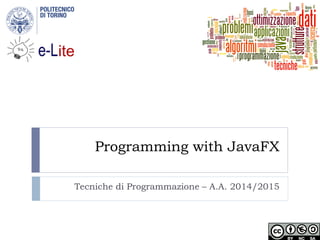
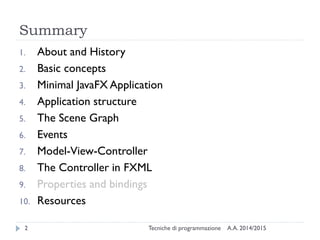

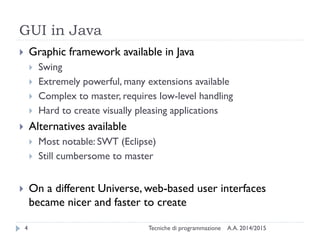


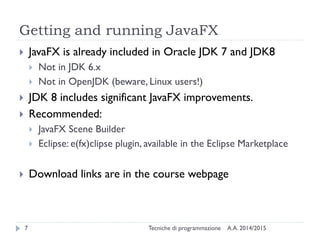



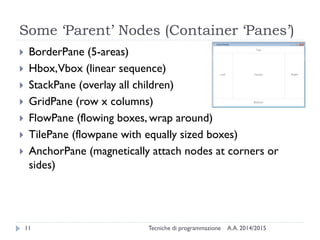

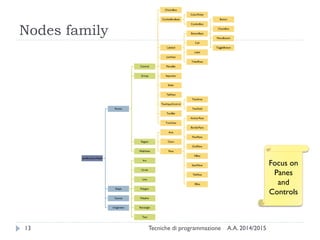

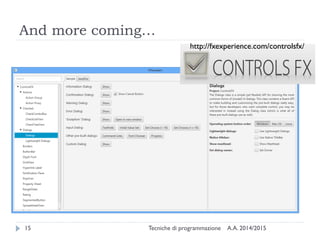
![Empty JavaFX window
A.A. 2014/2015Tecniche di programmazione16
public class Main extends Application {
@Override
public void start(Stage stage) {
Group root = new Group(); // the root is Group or Pane
Scene scene = new Scene(root, 500, 500, Color.BLACK);
stage.setTitle("JavaFX Demo");
stage.setScene(scene);
stage.show();
}
public static void main(String[] args) {
launch(args);
}
}](https://image.slidesharecdn.com/01-javafx-programming-150306091025-conversion-gate01/85/Programming-with-JavaFX-16-320.jpg)





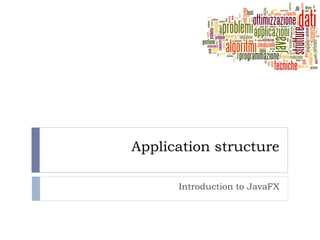



![Minimal example
A.A. 2014/2015Tecniche di programmazione27
public class HelloWorld extends Application {
public static void main(String[] args) {
launch(args);
}
@Override
public void start(Stage primaryStage) {
primaryStage.setTitle("Hello World!");
StackPane root = new StackPane();
Button btn = new Button();
btn.setText("Say 'Hello World'");
root.getChildren().add(btn);
primaryStage.setScene(new Scene(root, 300, 250));
primaryStage.show();
}
}](https://image.slidesharecdn.com/01-javafx-programming-150306091025-conversion-gate01/85/Programming-with-JavaFX-26-320.jpg)





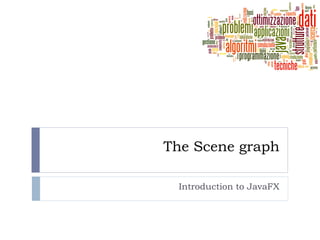






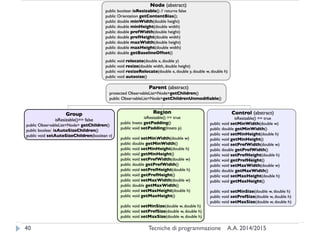









![A.A. 2014/2015Tecniche di programmazione50
public class HelloDevoxx extends Application {
public static void main(String[] args)
{
launch(args);
}
@Override
public void start(Stage primaryStage)
{
primaryStage.setTitle("Hello Devoxx");
Group root = new Group();
Scene scene = new Scene(root, 400, 250,
Color.ALICEBLUE);
Text text = new Text();
text.setX(105);
text.setY(120);
text.setFont(new Font(30));
text.setText("Hello Devoxx");
root.getChildren().add(text);
primaryStage.setScene(scene);
primaryStage.show();
}
}](https://image.slidesharecdn.com/01-javafx-programming-150306091025-conversion-gate01/85/Programming-with-JavaFX-49-320.jpg)
















